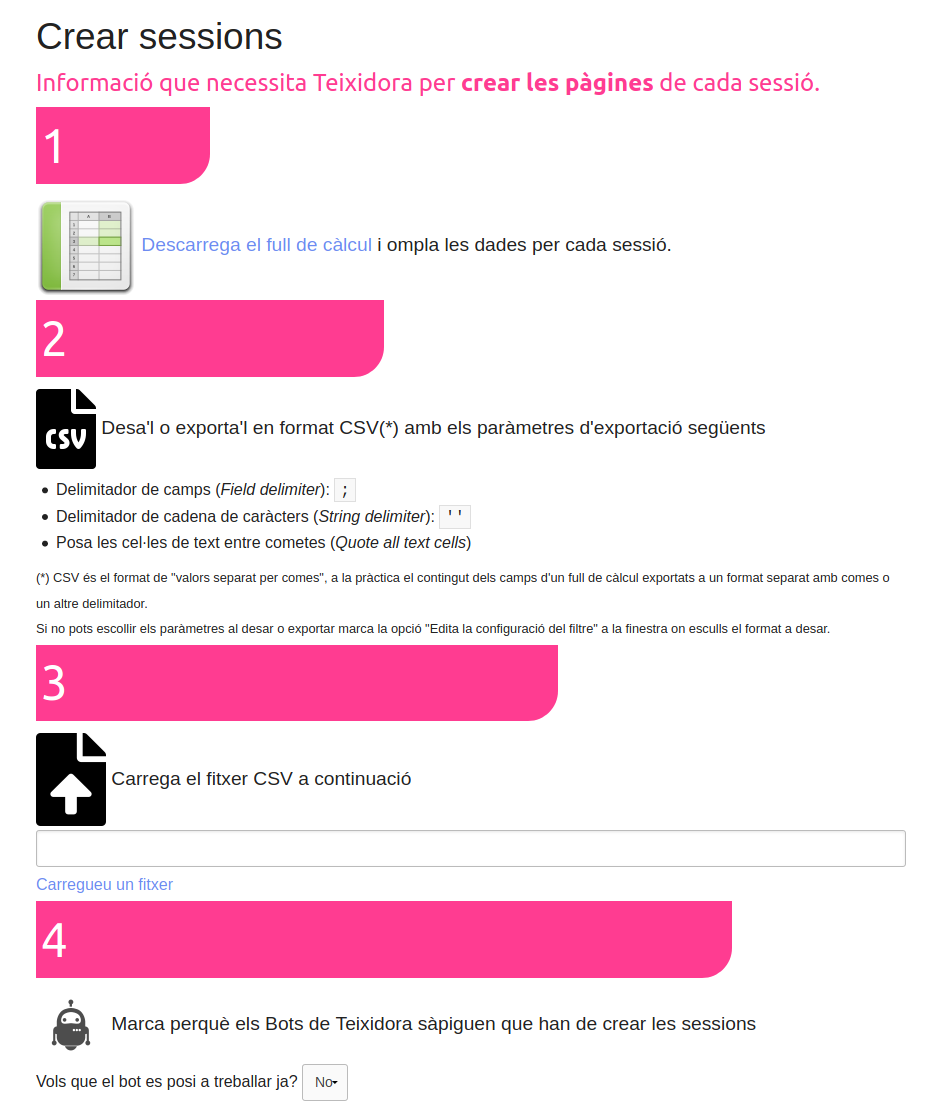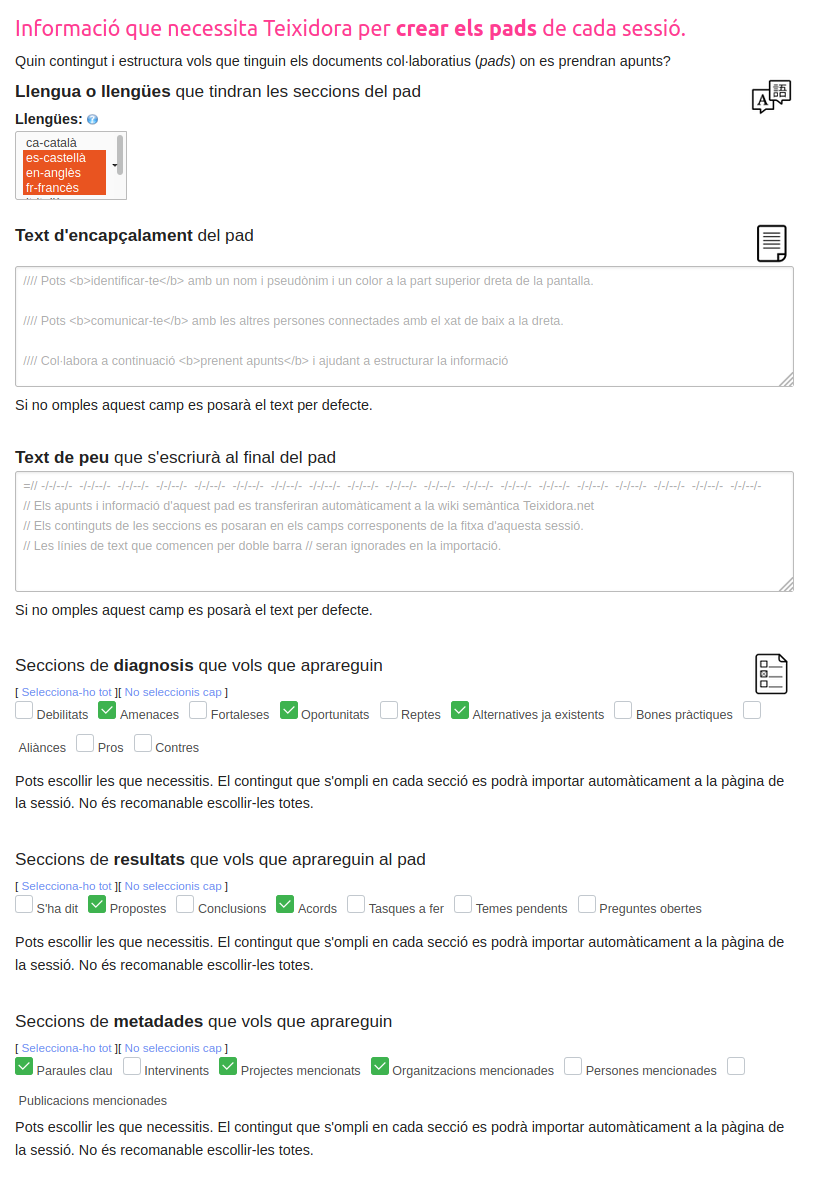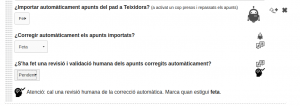This post is also available in: Español (Spanish) English
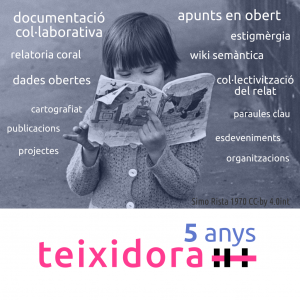 Un 16 de febrer de 2016, ara ja fa 5 anys, posàvem en marxa Teixidora.net. Durant aquests anys s’hi han recollit més de 480 sessions d’esdeveniments amb apunts, interconnectades entre si per paraules clau, organitzacions, projectes, persones i publicacions mencionades. El darrer any hem treballat a millorar-la, perquè sigui més fàcil fer-la servir i perquè els continguts i les connexions entre ells siguin de més qualitat.
Un 16 de febrer de 2016, ara ja fa 5 anys, posàvem en marxa Teixidora.net. Durant aquests anys s’hi han recollit més de 480 sessions d’esdeveniments amb apunts, interconnectades entre si per paraules clau, organitzacions, projectes, persones i publicacions mencionades. El darrer any hem treballat a millorar-la, perquè sigui més fàcil fer-la servir i perquè els continguts i les connexions entre ells siguin de més qualitat.
Amb el propòsit de col·lectivitzar la documentació i el relat vam desenvolupar una plataforma oberta per publicar apunts i documentació creada col·laborativament en esdeveniments. Aquesta documentació s’interconnecta en una wiki semàntica i es generen cartografies de context. Fem que els continguts produïts deixin rastre generant una estigmèrgia documental. En col·lectivitzar la documentació, també hem anat desenvolupant metodologies de facilitació i col·laboració.
Amb Teixidora volem contribuir a estendre la pràctica de documentar col·laborativament en obert. Per això la plataforma està a disposició de qui la vulgui fer servir, tant per aportar-hi continguts com per reutilitzar-los.
Des de molt aviat, Teixidora va comptar amb el suport de wikis.cc, que li ha proporcionat allotjament. També ha estat molt important poder comptar amb un sistema de pads estable com els que ha proporcionat La Mar de Bits. Des de 2018 el projecte és impulsat des del Grup d’Activitat Cooperativitzada Teixidora de la cooperativa integral femProcomuns. En el darrer any el grup ha empès un programa de millores de la plataforma i d’exploració de la interoperabilitat amb altres projectes, cooperant principalment amb la cooperativa Col·lectivaT i l’equip de Remix the Commons. Hi hem dedicat recursos propis i hem comptat també amb el suport de la Beca del Culture Solidarity Fund (Fons Cultura de Solidaritat) de l’European Cultural Foundation (ECF).
Què hem fet aquest any
Múltiples sessions: més fàcil
Quan un esdeveniment que volem documentar té múltiples sessions (com unes jornades, un congrés, un curs, etc.), cal crear a Teixidora una pàgina general de l’esdeveniment i després una pàgina per cada sessió. A banda d’aquestes pàgines, també cal tenir un pad per cada una de les sessions (amb l’estructura que s’hagi decidit per aquell esdeveniment). Hem simplificat aquest procés automatitzant-ne algunes parts. Comencem amb un full de càlcul on posem una llista de les sessions amb les seves dades (dia, horaris, intervinents, llengua, canal de retransmissió, etc.). És l’habitual full de càlcul que es va actualitzant en el període de preparació d’un esdeveniment.
Convertim el full de càlcul en un document separat per comes (format CSV) i des d’un formulari de Teixidora l’importem. En aquest mateix formulari escollim l’estructura que volem que tinguin els pads. Recollir apunts de forma estructurada és un factor clau perquè la documentació col·laborativa després s’interconnecti entre si. Però no tots els esdeveniments són iguals i no sempre ens interessa recollir el mateix. Solem recollir sempre paraules clau que ajuden a saber de què s’ha tractat a l’esdeveniment. També recollim allò que s’ha mencionat: organitzacions, projectes, publicacions i a vegades també persones (activistes, autors/es, polítics/ques, …). Si l’esdeveniment se centra en el diagnòstic d’una qüestió, potser volem recollir reptes i oportunitats, o bé pros i contres. Si forma part d’un procés participatiu, potser volem recollir propostes o identificar alternatives existents. Si és un grup que delibera i decideix podem voler recollir acords i temes que queden pendents per tractar aviat. Si és una xerrada de reflexió i pensament, potser es volen recollir preguntes que queden obertes o destacar algunes frases que s’hi han dit. L’equip que prendrà apunts ha de decidir això amb els organitzadors i/o els participants a l’esdeveniment i escollir-ho al formulari. Un cop fet i desat es crea la pàgina general de l’esdeveniment i un “Bot” (programa automàtic) s’encarrega de crear una pàgina a Teixidora per cada sessió que hi ha al full de càlcul i un pad d’edició col·laborativa per cada una de les sessions. Tots aquests pads es creen ja automàticament amb l’estructura que s’ha escollit i queden enllaçats a Teixidora.
Importació d’apunts i corrector
Des de 2017 Teixidora té un Bot que importa el contingut d’un pad (on s’han pres apunts) i el copia al wiki, respectant el format del text (en fa la conversió) i detectant les seccions del pad que corresponen a un paràmetre de les plantilles-fitxa de les pàgines de Teixidora. Si detecta una secció extreu aquell contingut i, en lloc de deixar-lo als apunts, el mou al lloc on pertoca. Un exemple clar pot ser el de les paraules clau. Si es detecta una secció al pad que es diu “Paraules clau” agafa el contingut per separat i aquelles paraules que hem posat al pad es converteixen en enllaços a la resta de continguts a Teixidora que tinguin aquella mateixa paraula clau. I el mateix amb els projectes i les organitzacions mencionades, per exemple. Doncs bé, seguint aquest procediment hem anat detectant possibles millores pel Bot d’importació, que hem implementat aquest any.
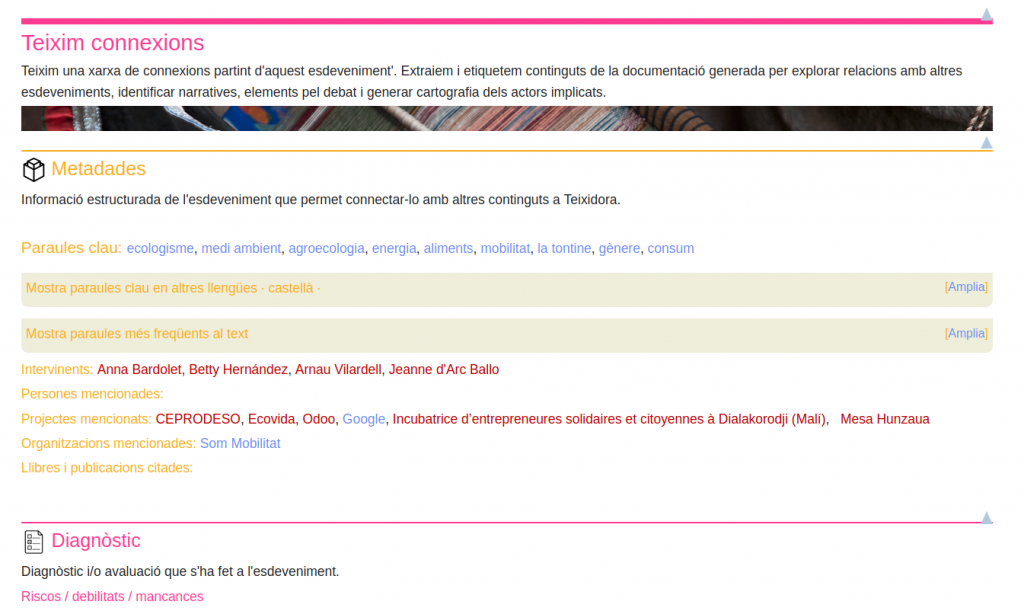 D’altra banda en la presa d’apunts se solen cometre errors d’escriptura, tant tipogràfics com ortogràfics. Tenir el text en una plataforma digital permet passar-hi un corrector automàtic i el fet que la plataforma sigui una wiki col·laborativa permet que es pugui combinar amb edició humana. Amb la col·laboració de Col·lectivaT hem incorporat un corrector multilingüe (Teixidora acumula apunts, principalment en català, castellà, francès i anglès). Quan volem que passi el corrector ho marquem a la pàgina de la sessió corresponent, el corrector genera una pàgina corregida i ho marca perquè sigui revisat per una persona. Un cop revisat, el text corregit substitueix el text importat. Hem començat a “pentinar” els continguts acumulats passant-los el corrector i fent-ne la revisió (si ens vols ajudar en aquesta tasca, contacta amb nosaltres).
D’altra banda en la presa d’apunts se solen cometre errors d’escriptura, tant tipogràfics com ortogràfics. Tenir el text en una plataforma digital permet passar-hi un corrector automàtic i el fet que la plataforma sigui una wiki col·laborativa permet que es pugui combinar amb edició humana. Amb la col·laboració de Col·lectivaT hem incorporat un corrector multilingüe (Teixidora acumula apunts, principalment en català, castellà, francès i anglès). Quan volem que passi el corrector ho marquem a la pàgina de la sessió corresponent, el corrector genera una pàgina corregida i ho marca perquè sigui revisat per una persona. Un cop revisat, el text corregit substitueix el text importat. Hem començat a “pentinar” els continguts acumulats passant-los el corrector i fent-ne la revisió (si ens vols ajudar en aquesta tasca, contacta amb nosaltres).
TeixiReptes, nous fils, interoperabilitat entre wikis i multilingüisme
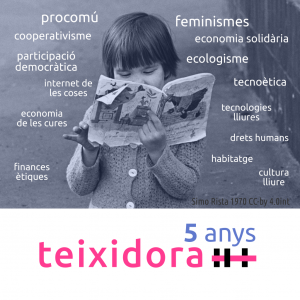 Aquest any hem obert dues pàgines de TeixiRepte que faciliten la col·laboració per completar continguts que no existeixen a Teixidora, però que haurien d’existir, perquè han estat mencionats en algun esdeveniment. La wiki semàntica ens permet descobrir el què ha estat mencionat (organització, projecte, persona, publicació) i hauria de tenir una pàgina. Ho mostrem a la pàgina del TeixiRepte perquè sigui fàcil de crear-les. Tenim el TeixiRepte femBlaus que és més exhaustiu, sobre tots els continguts mencionats, i un TeixiRepte més específic dedicat a temàtica feminista que es diu femLiles.
Aquest any hem obert dues pàgines de TeixiRepte que faciliten la col·laboració per completar continguts que no existeixen a Teixidora, però que haurien d’existir, perquè han estat mencionats en algun esdeveniment. La wiki semàntica ens permet descobrir el què ha estat mencionat (organització, projecte, persona, publicació) i hauria de tenir una pàgina. Ho mostrem a la pàgina del TeixiRepte perquè sigui fàcil de crear-les. Tenim el TeixiRepte femBlaus que és més exhaustiu, sobre tots els continguts mencionats, i un TeixiRepte més específic dedicat a temàtica feminista que es diu femLiles.
Pensant en les persones que fan servir Teixidora com a eina de consulta, anem observant quan ja hi ha continguts rellevants sobre una temàtica i creem “fils” amb consultes semàntiques que agrupen els continguts sobre aquesta. Ja teníem els fils “participació política“, “gènere i tecnologia“, “internet de les coses” i “MWC i alternatives“. Hem afegit un nou fil per “feminismes” i un altre sobre la “COVID19“.
A més ja fa temps que col·laborem amb l’organització francòfona Remix the Commons, que també té una wiki semàntica on documenta experiències, iniciatives i conceptes, sobretot al voltant dels procomuns i les seves pràctiques afins. Hi ha similituds i diferències entre els dos wikis que hem estudiat i hem treballat conjuntament per fer, per exemple, que l’estructura de continguts per documentar “projectes” sigui similar i per crear un nou tipus de pàgina a Teixidora per documentar “conceptes” que es basa en la que tenen al seu wiki. Aquest any hem coincidit amb Remix the Commons (i amb altres organitzacions i persones) en l’organització i participació al Commons Camp de Marsella, a l’eix procomú del Fòrum Social Mundial de les Economies Transformadores, així com a la posada en marxa del procés Horitzons Comuns. Hem documentat les trobades relacionades amb aquests processos i esdeveniments a Teixidora, hem assajat formes de prendre apunts simultanis en múltiples llengües (amb i sense el suport d’interpretació simultània professional) i hem debatut sobre la forma de recollir i estructurar la informació.
Què més hem fet i què estem fent
Ha estat un any molt actiu. Hem fet més coses, entre elles: diverses millores en la interfície i en l’estructura de les pàgines de Teixidora (esdeveniments, publicacions i projectes, entre altres), així com en els formularis; afegir a les pàgines paraules clau i descripcions en altres llengües diferents del català; i hem creat noves categories que ajuden a localitzar pàgines segons els continguts de documentació que hi ha. També hem creat un grup “Teixidora contrast” amb persones que coneixen el projecte i amb les quals consultem i contrastem algunes decisions sobre cap on ha d’anar la plataforma. També hem començat a fer algunes coses amb les quals encara estem treballant:
- Generalitzar el bot d’importació: el que estem fent és que el bot no sigui només per importar apunts d’esdeveniments. Volem que es pugui crear o actualitzar qualsevol classe de pàgina des d’un pad. Hem començat per fer-ho amb la pàgina de projectes. Podem, per exemple, fer una hackathon per documentar projectes sobre una temàtica col·laborativament en un pad i després fer una importació que generi i actualitzi les pàgines. Ho estem fent pensant que aquesta importació es pugui fer simultània a Teixidora i a altres wikis, de manera que una sessió conjunta de treball pugui acabar documentada en més d’una plataforma, estem treballant per testejar-ho amb Remix the Commons.
- Lligacaps: estem utilitzant tecnologia d’aprenentatge de màquina per detectar els “elements nexe”, que interconnecten continguts (organitzacions, projectes, persones) si hi ha similituds que puguin ser errors o que puguin ser relacions. Per exemple volem indicar que “XES” i “Xarxa d’Economia Solidària de Catalunya” és un mateix element i que així no quedi com un element separat. Però també volem indicar que “XES procomuns” és una comissió que “forma part” de “XES”. La detecció es fa automàticament i després la intervenció humana la valida o no.
Què pots fer amb Teixidora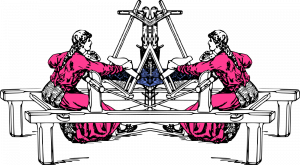
Si t’interessa consultar els continguts que s’hi recullen
- Estira algun dels fils del seu teler i descobreix apunts, informació, projectes i actors a partir d’un tema.
- Explora a través d’una de les seves subportades de Projectes, Organitzacions, Persones o Publicacions.
- Consulta els esdeveniments a través del mapa d’on han passat o de l’any en que han passat.
- Descobreix continguts a través d’una paraula clau o busca directament a l’eina de buscador.
- Però sobretot navega pels continguts, totes les pàgines tenen metadades que les interconnecten entre sí.
Si organitzes unes jornades, trobades, xerrades, formacions o algun altre tipus d’esdeveniment i vols documentar-los col·laborativament i compartir els continguts en obert.
- Pots utilitzar la Teixidora de forma autònoma consultant-ne la Guia.
- Pots demanar formació o acompanyament per fer servir la Teixidora a l’equip del GAC Teixidora de femProcomuns (teixidora@femprocomuns.coop).
- Potser encarregar-nos que organitzem la documentació amb un equip d’apuntaires o bé donant suport a apuntaires voluntaris.
Si elabores continguts periodístics, acadèmics, formatius o d’algun altre tipus i si treballes amb dades obertes
- Pots fer servir Teixidora per informar-te, per tenir context sobre un tema i saber què se n’ha dit o prendre continguts per reelaborar.
- Pots fer servir les dades de Teixidora per reelaborar i processar-les.
- Pots proposar-nos participar en un projecte de reelaboració de continguts o de tractament de dades.
Si impulses un projecte similar o complementari
- Podem estudiar-ne la interoperabilitat
- Podem importar i exportar dades i continguts o fer accions conjuntes per documentar.


